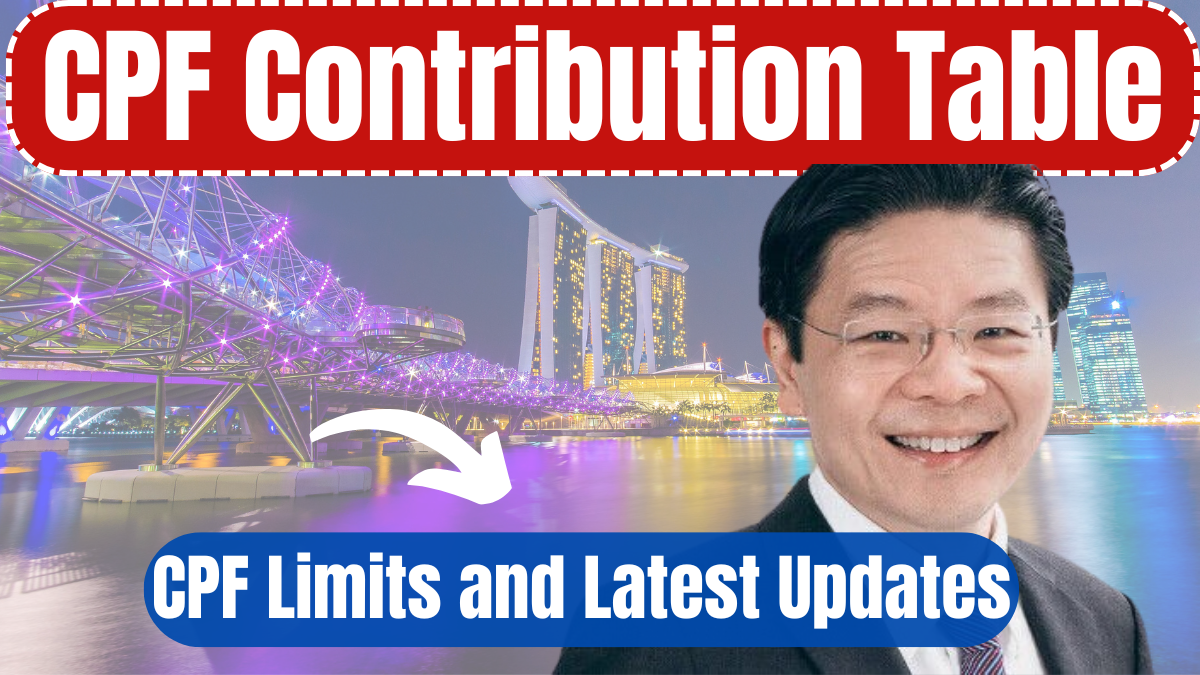The Central Provident Fund (CPF) is a compulsory savings scheme in Singapore aimed at ensuring that citizens and Permanent Residents (PRs) have enough savings for retirement, housing, and healthcare. Both employers and employees contribute a percentage of the employee’s salary to CPF accounts, which are divided into:
- Ordinary Account (OA): Used for housing, education, and investments.
- Special Account (SA): Dedicated to retirement savings.
- Medisave Account: Covers healthcare and medical insurance.
- Retirement Account (RA): Created at age 55 by combining savings from OA and SA.
These accounts offer competitive interest rates and serve as the backbone of Singapore’s long-term financial planning for its workforce.

Singapore CPF Contribution Table 2025
CPF contribution rates are determined based on the age of the employee, and the contributions are split between the employer and employee.
Here is the updated CPF Contribution Table effective from 1 March 2025:
| Age Group | Employer’s Contribution | Employee’s Contribution | Total CPF Contribution |
|---|---|---|---|
| Up to 55 years | 17% | 20% | 37% |
| 55 to 60 years | 15% | 16% | 31% |
| 60 to 65 years | 11.5% | 10.5% | 22% |
| 65 to 70 years | 9% | 7.5% | 16.5% |
| Above 70 years | 7.5% | 5% | 12.5% |
These contribution rates ensure that individuals build sufficient savings while adapting to reduced contributions in older age brackets.
CPF Limits and Wage Ceilings in 2025
To maintain sustainability, CPF contributions are capped by wage ceilings. For 2025, the CPF ceilings are as follows:
| Type | 2025 Limit |
|---|---|
| Ordinary Wage Ceiling | $6,800 per month |
| Additional Wage Ceiling | $102,000 per year (approx.) |
Example Scenario:
If an employee earns $6,800 monthly and receives a $50,000 bonus, only $20,400 of the bonus is subject to CPF contributions due to the annual additional wage ceiling.
This capping helps avoid over-contribution while ensuring fair accumulation of retirement savings.
CPF Contribution for Permanent Residents (PRs)
PRs have different contribution rates during their first two years of employment in Singapore. This gradual contribution structure is designed to help new PRs adjust financially.
| PR Employment Year | Employee Rate Range | Employer Rate Range |
|---|---|---|
| Year 1 | 5% to 15% | 4% to 9% |
| Year 2 | 7.5% to 12.5% | 6% to 15% |
| After Year 2 | Same as citizens | Same as citizens |
After the second year, PRs contribute at full citizen rates.
CPF Benefits in 2025
CPF continues to offer several key advantages in 2025, including:
-
Higher Interest Rates:
- Ordinary Account earns up to 3.5% annually.
- Special Account and Medisave earn up to 5%.
-
Retirement Security:
Funds from OA and SA are combined into a Retirement Account at age 55, ensuring stable income in later life. -
Medical & Housing Coverage:
CPF balances can be used to pay hospital bills, insurance premiums, and HDB loan repayments. -
Employer Contributions:
Employers are required by law to contribute to CPF, providing an automatic savings boost for every worker.
Important CPF Submission Details for Employers
Employers must:
- Submit CPF contributions via CPF website using SingPass or CorpPass.
- Use CPF PAL files (.txt format) for batch submissions.
- Make payments via GIRO, eNETS, AXS, or direct debit.
| Contribution Month | Submission Deadline |
|---|---|
| March 2025 | By 31 March 2025 |
| Grace Period | Up to 14 April 2025 |
Late payments may result in penalties and interest, so staying on time is crucial.
Read More: Government Payout Increase 2025: Maximise Your CPF in Singapore
Read More: $2500 Workfare Payout 2025: Eligibility and Payment Dates
FAQs
What is the CPF contribution cap for 2025?
The Ordinary Wage ceiling is $6,800/month, and the Additional Wage ceiling is roughly $102,000 annually.
How does CPF benefit me if I’m under 30?
CPF helps you save for housing, healthcare, and future retirement, while earning high interest rates compared to bank savings.
When can I withdraw my CPF funds?
You can begin drawing from your Retirement Account at age 63, while OA and Medisave are restricted to specific use cases.
Are CPF contributions mandatory for PRs?
Yes, CPF contributions are compulsory for PRs, though they follow a phased rate structure in the first two years.
How can I calculate my CPF contribution?
Use the CPF calculator available on the official CPF website to estimate your monthly and annual contributions.
What happens if I earn above the wage ceiling?
Any income above the ceiling is not subject to CPF contributions, which caps your total monthly contribution.
Can I use CPF to pay for housing loans?
Yes, funds from your Ordinary Account can be used to pay for HDB loans and other property purchases.
Is CPF taxable or included in my income tax?
CPF contributions are not taxable, and employer contributions are also exempt from income tax.
Click here to know more.
Aanchal is a passionate writer with a keen interest in storytelling, content creation, and creative expression. She enjoys exploring diverse topics and crafting engaging narratives that captivate readers.